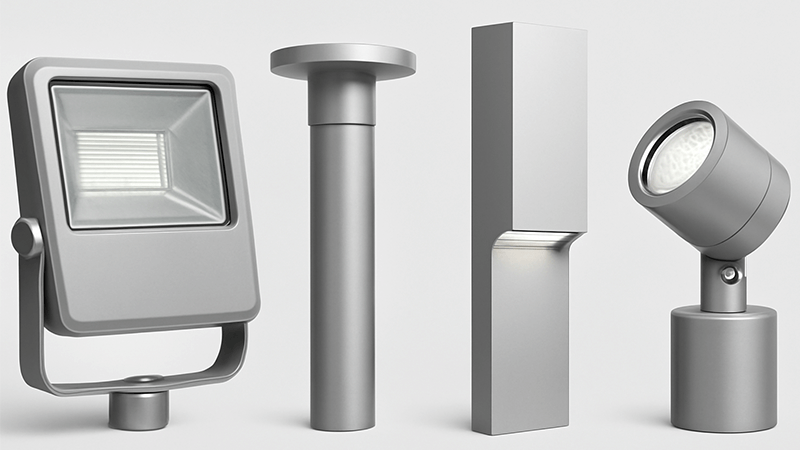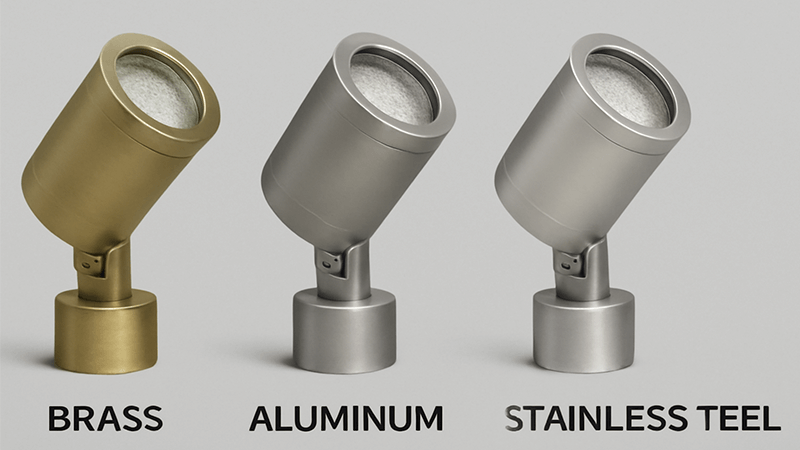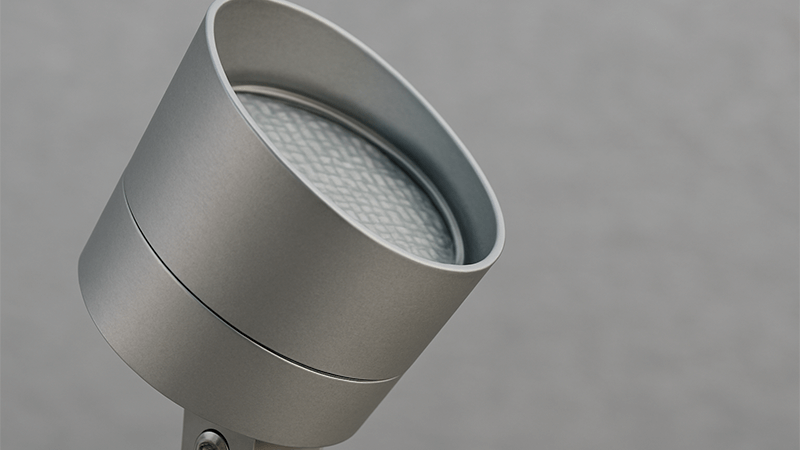Choosing materials for outdoor lights can be frustrating. A bad choice leads to rust and quick replacements. Aluminum, however, offers a durable, cost-effective solution you should seriously consider.
Yes, aluminum is an excellent material for outdoor lighting. Its natural ability to form a protective oxide layer makes it highly resistant to corrosion. It is also lightweight, strong, and great at dissipating heat, which extends the life of the LED components.

When I started in this industry, I spent years working on the factory floor. I saw firsthand how different materials reacted to the manufacturing process and, later, to the elements. This experience gave me a deep understanding that spec sheets alone can’t provide. There’s a lot of debate about the best material, but aluminum consistently proves its worth. Let’s break down why it’s a top choice for so many projects and compare it to other common options.
Are aluminum outdoor lights good?
You worry if aluminum lights can handle harsh outdoor conditions. This uncertainty might cause you to stick with more expensive options, missing out on a reliable and efficient solution.
Yes, aluminum outdoor lights are very good. They provide a fantastic balance of durability, corrosion resistance, and value. They are also lightweight, making them easier and cheaper to install and ship.

In my experience, "good" means a product is reliable, meets project requirements, and provides great value. Aluminum lights check all these boxes. Their performance goes beyond just looking good out of the box. It’s about how they perform year after year.
Let’s look at the details. The strength of aluminum is a major benefit. We use a process called die-casting, where we inject molten aluminum into a mold under high pressure. This creates a very dense and durable housing for the light. It’s strong enough to resist impacts but remains surprisingly lightweight. For a purchasing manager like Shaz, this means lower shipping costs and easier handling for installation crews, which saves money and time on a project.
Heat management is another critical factor, especially for LED lights. LEDs are sensitive to heat; if they get too hot, their lifespan and performance drop significantly. Aluminum is an excellent thermal conductor. It pulls heat away from the sensitive LED chips and dissipates it into the surrounding air. This keeps the light running cooler and for much longer. Better heat dissipation means a more reliable product and fewer warranty claims.
Here’s a breakdown of why aluminum is a solid choice:
| Feature |
Benefit for Outdoor Lights |
| Corrosion Resistance |
Forms a natural protective layer, ideal for humid or coastal areas like the UAE. |
| Lightweight |
Reduces shipping costs and makes installation easier and faster. |
| Heat Dissipation |
Keeps LED components cool, extending the fixture’s lifespan and maintaining brightness. |
| Recyclability |
An environmentally friendly choice, as aluminum can be recycled repeatedly. |
| Value for Money |
Offers performance comparable to more expensive materials at a lower cost. |
This combination of features makes die-cast aluminum a go-to material for high-quality outdoor lighting. It’s not just a budget option; it’s a smart, technical choice.
What is the best material for outdoor lighting?
With so many material options, you fear making the wrong choice. This could lead to premature failures, unhappy clients, and damage to your reputation. The truth is, the best material depends on your specific needs.
The "best" material depends on budget, environment, and desired look. Brass is premium and highly durable. Stainless steel is modern and strong. But die-cast aluminum often offers the best overall balance of performance, durability, and cost for most outdoor projects.

I’ve worked with them all, and there is no single "best" material for every situation. The ideal choice is always a trade-off between cost, durability, and aesthetics. A project in a dry, mild climate has different needs than one on a salty coast. Let’s compare the most common options to help you decide.
Material Deep Dive
Each material has its own set of strengths and weaknesses. As a purchasing manager, understanding these nuances is key to sourcing the right products for your projects.
-
Die-Cast Aluminum: As we’ve discussed, aluminum is the all-rounder. Its main advantage is its excellent value. Through die-casting and a quality powder-coating finish, it can resist the elements effectively. The key is the quality of the alloy and the thickness of the powder coat. I’ve seen some manufacturers cut corners here, which leads to chipping and corrosion. At Upward Lighting, we use ADC12 aluminum and a rigorous pre-treatment and powder-coating process to ensure the finish bonds tightly and lasts for years.
-
Brass: This is a premium choice. Brass is an alloy of copper and zinc and it does not rust. Over time, it develops a beautiful, dark patina that many people love. It’s extremely durable and a great choice for high-end residential or commercial projects, especially in coastal areas. The downside is cost and weight. Brass is significantly more expensive and heavier than aluminum, which increases both the product price and installation costs.
-
Stainless Steel: Known for its modern, clean look and strength. It’s very resistant to corrosion, but not all stainless steel is created equal. You need to look for marine-grade 316 stainless steel for the best protection in coastal or industrial areas. Grade 304 is common but can show surface rust in salty environments. Stainless steel is also more expensive than aluminum and can be difficult to work with, limiting design possibilities.
-
Copper: Like brass, copper is a premium material that develops a greenish-blue patina over time. It is highly resistant to corrosion and has a unique, classic look. However, it’s very soft, expensive, and heavy. It’s typically used for specialized, decorative fixtures rather than general-purpose landscape lighting.
Here is a summary table to help you compare:
| Material |
Durability |
Corrosion Resistance |
Cost |
Best For |
| Die-Cast Aluminum |
High |
Good to Excellent |
Medium |
General purpose, commercial projects, best overall value. |
| Brass |
Excellent |
Excellent |
High |
High-end residential, coastal areas, where longevity is the top priority. |
| Stainless Steel |
Excellent |
Excellent (Grade 316) |
High |
Modern designs, coastal and industrial areas, high-traffic locations. |
| Copper |
Good |
Excellent |
High |
Decorative and heritage projects, unique aesthetic appeal. |
For most of the projects my clients handle, die-cast aluminum hits the sweet spot. It delivers the durability and performance needed for commercial applications without the high price tag of brass or stainless steel.
Do aluminum outdoor lights rust?
You hear that metal rusts outdoors. This makes you worry that aluminum lights will corrode and fail, leading to costly replacements and unhappy customers.
No, aluminum does not rust. Rust is specifically iron oxide. Instead, aluminum undergoes oxidation, forming a hard, protective layer of aluminum oxide (Al₂O₃) on its surface. This layer prevents further corrosion.

This is a point that causes a lot of confusion, so it’s important to be clear. The term "rust" specifically refers to the red, flaky corrosion of iron or steel. Aluminum cannot rust because it contains no iron. However, like most metals, it does react with oxygen in the air. This process is called oxidation.
The key difference is what happens during oxidation. When iron oxidizes, it forms a porous, flaky layer of rust that falls off, exposing new metal to corrode. This process continues until the metal is destroyed. When aluminum oxidizes, it’s a completely different story. It instantly forms a microscopic, transparent, and very hard layer of aluminum oxide (Al₂O₃). This is the insight I shared earlier. This layer seals the metal surface and protects the raw aluminum underneath from any further contact with air or moisture. It’s like the metal has its own built-in, perfectly-fitted suit of armor.
This self-protecting feature is why raw aluminum can last for decades outdoors. For our outdoor lights, we don’t stop there. We add another layer of defense:
- Pre-treatment: Before painting, we put the die-cast aluminum housing through a series of chemical washes. This cleans the surface thoroughly and creates a micro-texture that helps the paint adhere better. This step is crucial and is often skipped by low-cost manufacturers.
- Powder Coating: We then apply a polyester powder coat, which is a dry powder that is electrostatically sprayed onto the fixture. The fixture is then baked in an oven, causing the powder to melt and form a thick, durable, and uniform plastic-like shell.
This two-step process encapsulates the aluminum, providing a robust barrier against scratches, UV rays, salt spray, and acid rain. The natural protective oxide layer acts as a final line of defense. If the powder coat ever gets deeply scratched, the aluminum underneath will just form a new oxide layer, preventing corrosion from creeping under the paint. This is why a well-made aluminum light fixture is so incredibly durable.
Is brass or aluminum better for landscape lighting?
You want the best for your projects, but you’re torn between the premium feel of brass and the practical value of aluminum. Choosing the "wrong" one could mean overspending or sacrificing longevity.
It depends on the project’s priority. Brass is better for ultimate longevity in harsh coastal environments. Aluminum is better for most other projects, offering excellent durability, design flexibility, and superior value for money.

This is a classic debate in the lighting industry, and one I have with clients all the time. The answer isn’t about which material is "better" overall, but which is the right tool for the job. Both are excellent choices, but they serve different market segments and project goals.
Let’s think about this from the perspective of a purchasing manager like Shaz, who manages large-scale projects. The decision often comes down to three factors: environment, budget, and design.
Environment
For projects located directly on the coast with constant exposure to salt spray, solid brass is undeniably superior. It simply will not corrode in that environment. While a high-quality powder-coated aluminum fixture will hold up very well, any deep scratches could eventually become a weak point. For the absolute highest level of durability in the harshest marine environments, brass is the safer long-term investment.
Budget and Value
This is where aluminum shines. For a large commercial or residential development, the cost difference between aluminum and brass is significant. Brass fixtures can be two to three times more expensive. When you are buying hundreds or thousands of lights, this difference can make or break a project budget. A high-quality die-cast aluminum fixture offers maybe 90% of the lifespan of a brass fixture for only 40% of the cost. For most projects, that trade-off represents enormous value. The money saved can be reallocated to other parts of the project or simply translate into a more competitive bid.
Design and Aesthetics
Brass has a timeless, classic look that is perfect for traditional or high-end residential properties. The natural patina it develops is a feature many designers and homeowners love. However, your color choice is limited to the finishes of brass. Aluminum, on the other hand, is a blank canvas. The powder-coating process allows us to produce fixtures in any color—black, bronze, white, gray, or even custom colors to match a building’s architecture. The die-casting process also allows for more complex and modern shapes than are typically possible with brass. If the project calls for a specific color scheme or a contemporary design, aluminum is the more versatile option.
Here’s my final take:
- Choose Brass When: The project is a high-end, "money-is-no-object" property, it’s located in an extremely harsh coastal environment, and the client desires a classic, timeless aesthetic.
- Choose Aluminum When: The project requires a balance of performance, budget, and design. It’s perfect for large-scale commercial, public, and residential projects where value, reliability, and aesthetic flexibility are key.
For the majority of the market, modern, high-quality aluminum lighting is the more practical and intelligent choice.
Conclusion
In summary, die-cast aluminum is an outstanding material for outdoor lighting, offering a winning combination of durability, performance, and value that is hard to beat for most applications.